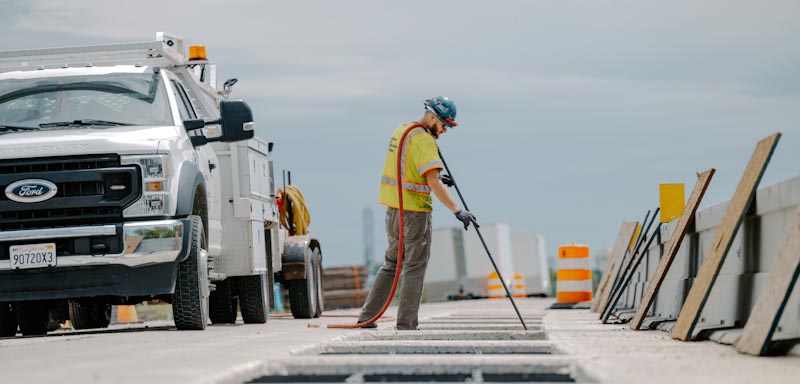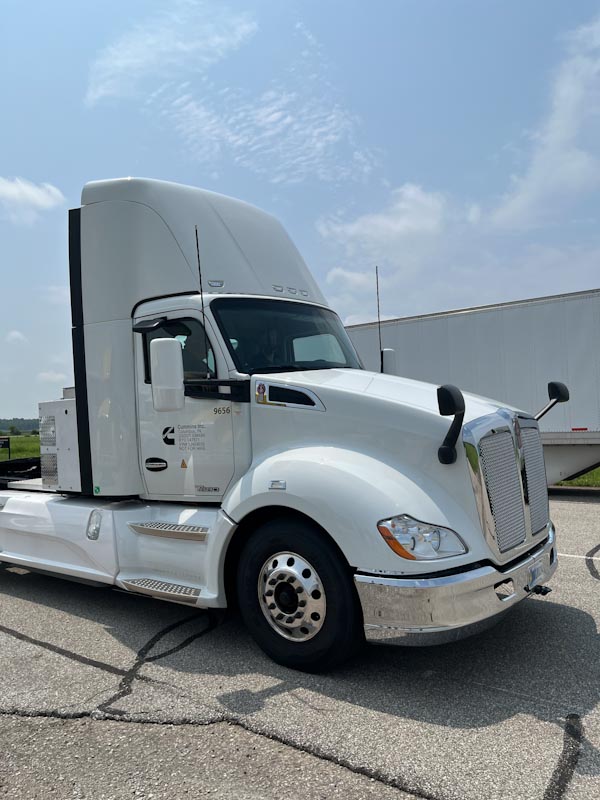Jan ’25 Indiana Pilot Updates

Photo Courtesy: Kelsey Lefever Purdue University
Highlights:
The ASPIRE/INDOT/AECOM/Cummins Dynamic Wireless Power Transfer (DWPT) pilot project has progressed well throughout the spring and summer of 2024. Pilot construction commenced on April 2, 2024 on US 231 in West Lafayette, IN. A key objective of the IN pilot is to demonstrate the performance of ASPIRE’s DWPT system designed to provide the power required (~200 kW) to move heavy-duty (Class 8 and 9) vehicles at highway speeds. To enable high power transfer and interoperability across vehicle classes, the transmitter (Tx) coils utilize ASPIRE’s rectangular three-phase topology.
The multiple steps taken to prepare the roadway included milling of channels for coil placement, horizontal and vertical boring to establish conduits to run transmitter leads to the road shoulder, locating buried vaults where inverters are being placed, and pouring of the polystyrene concrete overlay are provided in the link below:

Figure 1. Milling of channels for DWPT transmitter coil placement.


Figure 2. Boring used to establish a path for transmitter coil leads to roadway shoulder where electronics are located.

Figure 3. Transmitter coils (prior to concrete pour) in IN DWPT pilot.

Figure 4. Pouring of polystyrene concrete overlay.
Highlighted in the image below are ASPIRE’s graduate students Nick Frooninckx and Isaac Abram performing the acceptance testing of the coils subsequent to installation. Here, they are using an impedance analyzer in tandem with a custom test apparatus to ensure coils met desired performance specifications.

Figure 5. ASPIRE students Nick Frooninckx and Isaac Abram evaluating IN transmitter coils.
In addition to roadway construction, ASPIRE has been responsible for acceptance testing the inverters that are used to provide power to the Tx coils. Two of the inverters, developed by P.C. Krause and Associates, of Indianapolis, IN, are shown in Purdue’s Vehicle Systems Laboratory in Fig. 6 along with the transmitter and receiver system used for testing. Installation of the inverters is set to begin in March 2025 with roadway testing commencing in April 2025.


Figure 6. Inverters for the IN DWPT pilot (left) along with transmitter/receiver (right) being tested in Purdue’s Vehicle Systems Laboratory.
In parallel with roadway construction, ASPIRE has been working with Cummins on the installation of the receiver coil on one of their Class 8 trucks, shown in Fig. 7, that will serve as a test vehicle. The ASPIRE developments include instantiating the receiver coil and dc-dc converter that will tie to the vehicle dc bus and power management control system. Vehicle testing is expected to commence in early summer of 2025.
ASPIRE has also been working in tandem with INDOT to engage with the local community by providing public information sessions, developing and implementing surveys, and using the surveys to understand community perceptions and concerns before, during, and post pilot construction. A public information meeting was held on September 4, 2024 at the INDOT Division of Research & Development. Pictures from the event are shown in Fig. 8-9.

Figure 7. Cummins test vehicle for IN pilot.

Figure 8: ASPIRE/INDOT hosting public information meeting about ASPIRE/INDOT pilot in September 2024.

Figure 9. ASPIRE students Bruno Krause Moras, Oscar Moncada, Ben O’ Brien and ASPIRE PostDoc, Dr. Chiara Cervini with Professor Nadia Gkritza at the ASPIRE/INDOT public information meeting.